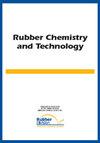用于测定保质期的丁基和溴丁基飞机内管的加速热老化
IF 1.5
4区 工程技术
Q4 POLYMER SCIENCE
引用次数: 0
摘要
航空航天标准AS50141为军用飞机规定的丁基和溴丁基内管在40至120°C的温度范围内进行不同时间的热老化,然后测量其硬度和机械性能。用1H双量子核磁共振(DQ NMR)研究了交联密度和分布的变化。使用老化数据的时间-温度叠加和阿伦尼斯方法来确定近似保质期。两种橡胶都发生了高温(80–120°C)和低温(40–80°C)氧化过程。在80°C以下,观察到交联密度、硬化、硬化和伸长率损失的增加。增塑剂和挥发性损失有助于化合物硬化。热老化过程中硫交联网络的改性可以解释最终性能损失和刚度增加的原因。扩散限制氧化发生在80°C以上,形成了由离子交联组成的薄氧化层,影响硬度和机械性能。对于丁基橡胶,硬度上升和最终性能稳定,这可能是由于断链反应的扩散,而对于溴丁基橡胶,交联反应占主导地位,而断链事件占主导地位。通过DQ NMR测量的交联密度和缺陷组分B和C与物理性质测试结果一致。由于交联密度分布的加宽,在暴露于更高的温度和更长的老化时间时,通过DQ NMR正则化视觉上感知到的网络的异质性程度增加。对丁基和溴丁基橡胶的低温和高温氧化过程计算了类似的阿伦尼斯活化能。丁基和溴丁基内管的预计保质期分别为10年和20年。DQ NMR测试结果(交联密度及其分布、缺陷水平)首次成功应用于支持保质期测定。本文章由计算机程序翻译,如有差异,请以英文原文为准。
Accelerated Heat Aging of Butyl and Bromobutyl Aircraft Inner Tubes for Shelf Life Determination
Butyl and bromobutyl inner tubes, specified by the Aerospace Standard AS50141 for military aircraft, were thermally aged from 40 to 120 °C for varying lengths of time and then their hardness and mechanical properties were measured. 1H double quantum nuclear magnetic resonance (DQ NMR) was used to elucidate crosslink density and distribution changes. Time–temperature superposition of the aged data coupled with the Arrhenius approach was used to determine an approximate shelf life. High (80–120 °C) and low (40–80 °C) temperature oxidation processes were occurring for both rubbers. Below 80 °C, an increase in crosslink density, hardening, stiffening, and loss of elongation was observed. Plasticizer and volatile loss contributes to compound stiffening. Sulfur crosslink network modifications during thermal aging can explain ultimate property loss and stiffness increase. Diffusion limited oxidation was taking place above 80 °C, with the development of a thin oxidized layer composed of ionic crosslinking that affected both hardness and mechanical properties. For butyl rubber, the hardness rise stabilizes as do the ultimate properties, likely due to the proliferation of chain scission reactions, whereas crosslinking reactions prevailed over chain scission events for bromobutyl rubber. Crosslink density and defect fractions B and C as measured through DQ NMR were in agreement with the physical property testing results. The degree of heterogeneity of the network as perceived visually through DQ NMR regularization increases upon exposure to higher temperatures and longer aging times due to the broadening of the crosslink density distribution. Similar Arrhenius activation energies were calculated for the low and high temperature oxidation process for butyl and bromobutyl rubbers. The projected shelf life for the butyl and bromobutyl inner tubes was 10 and 20 yr, respectively. For the first time, DQ NMR testing results (crosslink density and its distribution, defect level) have been successfully applied to support a shelf life determination.
求助全文
通过发布文献求助,成功后即可免费获取论文全文。
去求助
来源期刊

Rubber Chemistry and Technology
工程技术-高分子科学
CiteScore
3.50
自引率
20.00%
发文量
21
审稿时长
3.6 months
期刊介绍:
The scope of RC&T covers:
-Chemistry and Properties-
Mechanics-
Materials Science-
Nanocomposites-
Biotechnology-
Rubber Recycling-
Green Technology-
Characterization and Simulation.
Published continuously since 1928, the journal provides the deepest archive of published research in the field. Rubber Chemistry & Technology is read by scientists and engineers in academia, industry and government.
 求助内容:
求助内容: 应助结果提醒方式:
应助结果提醒方式:


